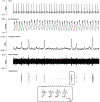The impact of ageing and sex on sympathetic neurocirculatory regulation
- PMID: 33468420
- PMCID: PMC8282778
- DOI: 10.1016/j.semcdb.2021.01.001
The impact of ageing and sex on sympathetic neurocirculatory regulation
Abstract
The sympathetic nervous system represents a critical mechanism for homoeostatic blood pressure regulation in humans. This review focuses on age-related alterations in neurocirculatory regulation in men and women by highlighting human studies that examined the relationship between muscle sympathetic nerve activity (MSNA) acquired by microneurography and circulatory variables (e.g., blood pressure, vascular resistance). We frame this review with epidemiological evidence highlighting sex-specific patterns in age-related blood pressure increases in developed nations. Indeed, young women exhibit lower blood pressure than men, but women demonstrate larger blood pressure increases with age, such that by about age 60 years, blood pressure is greater in women. Sympathetic neurocirculatory mechanisms contribute to sex differences in blood pressure rises with age. Muscle sympathetic nerve activity increases with age in both sexes, but women demonstrate greater age-related increases. The circulatory adjustments imposed by MSNA - referred to as neurovascular transduction or autonomic (sympathetic) support of blood pressure - differ in men and women. For example, whereas young men demonstrate a positive relationship between resting MSNA and vascular resistance, this relationship is absent in young women due to beta-2 adrenergic vasodilation, which offsets alpha-adrenergic vasoconstriction. However, post-menopausal women demonstrate a positive relationship between MSNA and vascular resistance due to a decline in beta-2 adrenergic vasodilatory mechanisms. Emerging data suggest that greater aerobic fitness appears to modulate neurocirculatory regulation, at least in young, healthy men and women. This review also highlights recent advances in microneurographic recordings of sympathetic action potential discharge, which may nuance our understanding of age-related alterations in sympathetic neurocirculatory regulation in humans.
Keywords: Ageing; Blood pressure; Microneurography; Muscle sympathetic nerve activity; Neural control of the circulation; Neurovascular transduction; Sex differences.
Copyright © 2021 Elsevier Ltd. All rights reserved.
Conflict of interest statement
Declaration of interests
The authors declare that they have no known competing financial interests or personal relationships that could have appeared to influence the work reported in this paper.
Figures



Similar articles
-
Sex differences in the sympathetic neurocirculatory responses to chemoreflex activation.J Physiol. 2022 Jun;600(11):2669-2689. doi: 10.1113/JP282327. Epub 2022 May 12. J Physiol. 2022. PMID: 35482235 Free PMC article. Clinical Trial.
-
Sex, ageing and resting blood pressure: gaining insights from the integrated balance of neural and haemodynamic factors.J Physiol. 2012 May 1;590(9):2069-79. doi: 10.1113/jphysiol.2011.224642. Epub 2012 Feb 20. J Physiol. 2012. PMID: 22351633 Free PMC article. Review.
-
Neurovascular control of blood pressure is influenced by aging, sex, and sex hormones.Am J Physiol Regul Integr Comp Physiol. 2016 Dec 1;311(6):R1271-R1275. doi: 10.1152/ajpregu.00288.2016. Epub 2016 Nov 16. Am J Physiol Regul Integr Comp Physiol. 2016. PMID: 27856414 Free PMC article. Review.
-
Sex differences and blood pressure regulation in humans.Exp Physiol. 2016 Mar;101(3):349-55. doi: 10.1113/EP085146. Epub 2015 Aug 16. Exp Physiol. 2016. PMID: 26152788 Review.
-
Sex and age differences in the association between sympathetic outflow and central elastic artery wall thickness in humans.Am J Physiol Heart Circ Physiol. 2019 Sep 1;317(3):H552-H560. doi: 10.1152/ajpheart.00275.2019. Epub 2019 Jul 5. Am J Physiol Heart Circ Physiol. 2019. PMID: 31274352 Free PMC article.
Cited by
-
Attenuated cardiac autonomic function in humans with high-affinity hemoglobin and compensatory polycythemia.Am J Physiol Regul Integr Comp Physiol. 2023 May 1;324(5):R625-R634. doi: 10.1152/ajpregu.00113.2022. Epub 2023 Mar 6. Am J Physiol Regul Integr Comp Physiol. 2023. PMID: 36878486 Free PMC article.
-
Age-related alterations in the cardiovascular responses to acute exercise in males and females: role of the exercise pressor reflex.Front Physiol. 2023 Nov 2;14:1287392. doi: 10.3389/fphys.2023.1287392. eCollection 2023. Front Physiol. 2023. PMID: 38028783 Free PMC article. Review.
-
Sympathetic transduction to blood pressure during euglycemic-hyperinsulinemia in young healthy adults: role of burst amplitude.Am J Physiol Regul Integr Comp Physiol. 2023 Apr 1;324(4):R536-R546. doi: 10.1152/ajpregu.00162.2022. Epub 2023 Feb 20. Am J Physiol Regul Integr Comp Physiol. 2023. PMID: 36802950 Free PMC article.
-
The sympathetic nervous system in heart failure revisited.Heart Fail Rev. 2024 Mar;29(2):355-365. doi: 10.1007/s10741-023-10345-y. Epub 2023 Sep 14. Heart Fail Rev. 2024. PMID: 37707755 Review.
-
Effect of acute intranasal insulin administration on muscle sympathetic nerve activity in healthy young adults.Am J Physiol Heart Circ Physiol. 2024 Jul 1;327(1):H000. doi: 10.1152/ajpheart.00253.2024. Epub 2024 May 24. Am J Physiol Heart Circ Physiol. 2024. PMID: 38787381 Free PMC article.
References
-
- Whelton PK, Carey RM, Aronow WS, Casey DE Jr, Collins KJ, Dennison Himmelfarb C, DePalma SM, Gidding S, Jamerson KA, Jones DW, Guideline for the prevention, detection, evaluation, and management of high blood pressure in adults: a report of the American College of Cardiology/American Heart Association Task Force on Clinical Practice Guidelines, J. Am. Coll. Cardiol 71 (2017) 1269–1324. - PubMed
-
- Forouzanfar MH, Liu P, Roth GA, Ng M, Biryukov S, Marczak L, Alexander L, Estep K, Abate KH, Akinyemiju TF, Global burden of hypertension and systolic blood pressure of at least 110 to 115 mm Hg, 1990–2015, Jama 317 (2017) 165–182. - PubMed
-
- Chobanian AV, Bakris GL, Black HR, Cushman WC, Green LA, Izzo JL Jr, Jones DW, Materson BJ, Oparil S, Wright JT Jr, Seventh report of the joint national committee on prevention, detection, evaluation, and treatment of high blood pressure, Hypertension. 42 (2003) 1206–1252. - PubMed
-
- Martins D, Nelson K, Pan D, Tareen N, Norris K, The effect of gender on age-related blood pressure changes and the prevalence of isolated systolic hypertension among older adults: data from NHANES III., J. Gender-Specific Med. JGSM Off. J. Partnersh. Women’s Heal. Columbia 4 (2001) 10. - PubMed
Publication types
MeSH terms
Grants and funding
LinkOut - more resources
Full Text Sources
Other Literature Sources

